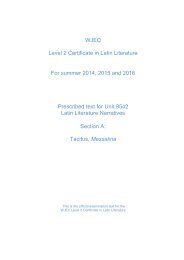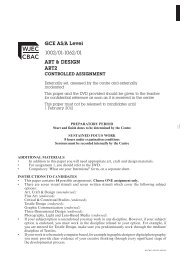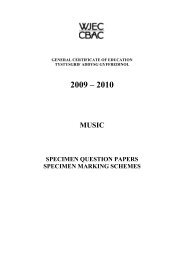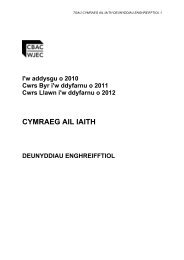WRITING ABOUT ART, ARTISTS AND ARTEFACTS - WJEC
WRITING ABOUT ART, ARTISTS AND ARTEFACTS - WJEC
WRITING ABOUT ART, ARTISTS AND ARTEFACTS - WJEC
You also want an ePaper? Increase the reach of your titles
YUMPU automatically turns print PDFs into web optimized ePapers that Google loves.
SPEAKING <strong>AND</strong> <strong>WRITING</strong> <strong>ABOUT</strong> <strong>ART</strong>, <strong>ART</strong>ISTS <strong>AND</strong> <strong>ART</strong>EFACTS<br />
WHAT SHOULD I TALK <strong>AND</strong>/OR WRITE <strong>ABOUT</strong><br />
You need to show evidence of your contextual understanding. That is your ability to<br />
understand the work of artists, craftspeople and designers. How and why the works were<br />
created; and how these works have influenced you and informed your own practice.<br />
<strong>ART</strong> IS A PRACTICAL SUBJECT. WHY DO I NEED TO WRITE <strong>AND</strong>/OR TALK<br />
<strong>ABOUT</strong> <strong>ART</strong> & <strong>ART</strong>ISTS<br />
To achieve in GCSE <strong>ART</strong> & Design you need to address all FOUR ASSESSMENT<br />
OBJECTIVES. As part of this process you must develop your ideas in <strong>ART</strong> by writing down<br />
your thoughts and processes, explaining the links you are making between your own work<br />
and other Art and Artists. This especially applies to AO1 Contextual Understanding, but is<br />
also important throughout the other Assessment Objectives; in your explanations and<br />
evaluations: of experiments; creative decisions; developments; refinements and outcomes.<br />
The framework below will help you to get started when discussing and writing about Art and<br />
Artefacts. You can use this framework to discuss your own work too. Class discussion in<br />
groups with your peers and with your teacher will help to establish good practice, and your<br />
responses can be recorded in writing or other forms. You can add in your own words to the<br />
relevant sentence starters so that they relate to the works you are studying or your own<br />
work.<br />
<strong>ART</strong> FOCUS or PROMPT<br />
Sentence starters<br />
1. BACKGROUND INFORMATION<br />
What is the image or artefact<br />
Does it have a name or title<br />
Who made the work<br />
Where was it created<br />
Does it belong to a particular Art movement or<br />
tradition<br />
2. WHAT ELSE DO YOU KNOW <strong>ABOUT</strong> IT<br />
What size or shape is it<br />
What material/s is it made from<br />
What is the subject matter<br />
Is the image or artefact realistic or abstract<br />
The piece of work that I have chosen to write<br />
about is called ‘A few snips’<br />
The artist who made it is Frida Kahlo<br />
It was made in her home in New Mexico<br />
The work belongs to a period called: (Surrealism,<br />
Art Nouveau, Pop Art, etc.)<br />
This work belongs to: (The Arts and Crafts,<br />
Vorticist, Fuave movement, etc.).<br />
The piece is a free standing sculpture…….<br />
The composition is one of a series….<br />
The composition is a life sized double-portrait<br />
consisting of…..<br />
The piece of art contains mixed media, which<br />
incorporates collage, acetate, sand, oil paint…<br />
The painting is highly realistic or ‘hyper<br />
realistic’..<br />
The painting is a miniature, to be worn around<br />
the neck of a loved one in a locket.<br />
The piece is created from organic found objects<br />
in the natural environment and has been
documented in a series of photographs.<br />
3. WHY WAS IT MADE WHAT IS ITS<br />
PURPOSE OR MEANING<br />
What do you think the<br />
painting/sculpture/artefact is about<br />
Does it have a story or are there any interesting<br />
facts you can relate about it<br />
Can you explain why the artist created this piece<br />
of work<br />
4. HOW HAS IT BEEN CREATED<br />
HOW HAVE THE VISUAL ELEMENTS BEEN<br />
USED<br />
COMPOSITION<br />
LINE<br />
TONE<br />
TEXTURE<br />
COLOUR<br />
FORM<br />
PATTERN<br />
5. WHAT MATERIALS, PROCESSES,<br />
EQUIPMENT OR TECHNIQUES HAVE BEEN<br />
USED<br />
Materials:<br />
Pencil / charcoal / oil paint / watercolour / fabric<br />
/ paper / thread / clay/ mixed-media / metal /<br />
card / wood, etc.<br />
Processes:<br />
Drawing/painting/carved/printed/ use of digital<br />
software, sewing, etc.<br />
Equipment:<br />
Camera, lighting, computer, printing press, lasercutter,<br />
printing press, roller, etc<br />
Techniques,<br />
Impasto, wax-resist, aquatint, glazing, free-arm<br />
embroidery, digital layering, lost wax, sgraffito,<br />
fusing, glazing, etc.<br />
6. WHAT COMMENTS CAN YOU MAKE <strong>ABOUT</strong><br />
THE WORK<br />
How do you feel about the work and why<br />
Is there anything you particularly like or don’t<br />
like about it<br />
The painting is an abstract composition based on<br />
a city landscape…..<br />
This aboriginal painting contains a story within<br />
its design…<br />
The artist created this piece of work to<br />
communicate how the horrors of war because…<br />
The artist created these paintings to show how<br />
light changes during different times of the day…<br />
The artist used short broken lines to create his<br />
drawing…<br />
The stone sculpture has been polished to a very<br />
shiny …<br />
The colours used are bright and full of joy and it<br />
makes the viewer feel….<br />
The colours used are dull and evoke a sad mood<br />
….<br />
The composition is very dynamic and exciting…..<br />
I particularly like the shapes and colours because<br />
they are harmonious / organic and remind me<br />
of…..<br />
The artist has used a combination of wood, metal<br />
and wire in the construction of …..<br />
This piece is created using fleece and natural<br />
dyes.<br />
The relief print was created using the cut-towaste<br />
or reduction method.<br />
This photograph was taken with a digital camera<br />
using a slow shutter speed so that the artist<br />
could ‘draw’ with light.<br />
In her etching …. has worked on a zinc plate,<br />
which provides a cleaner and more detailed<br />
image. The use of aquatint has successfully<br />
rendered a variety of tones and textures and the<br />
original print has been heavily embossed through<br />
the pressure of a tight roller press.<br />
The sculpture had a huge impact on me when I<br />
viewed it at…….<br />
The painting is very disturbing and I do not like<br />
the emphasis on…..<br />
The artist was trying to teach the viewer lessons
How does it link with your work, ideas, themes or<br />
techniques and help you make progress<br />
What can you say about the scale of the piece<br />
Where did you see the piece Is it in a Museum,<br />
Art Gallery, Artist’s Blog….<br />
Why have you analysed this work and how can you<br />
use it, or how have you used it, to help develop<br />
your own ideas<br />
about right and wrong through visual symbols and<br />
I aim to use symbolism in ………<br />
The artefact is tiny, jewelled and precious, small<br />
enough to hold in the palm of your hand. It was<br />
displayed in a cabinet in a dimly lit at……<br />
In my exploration of colour relationships the<br />
discovery of the limited palette in this work has<br />
given me….

















